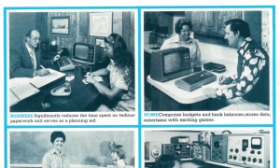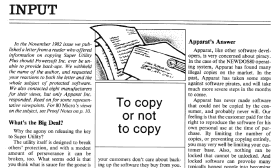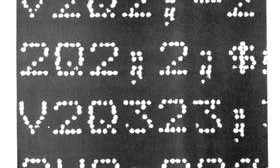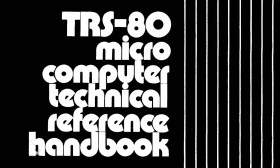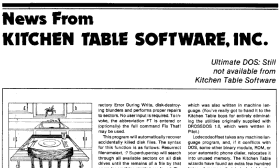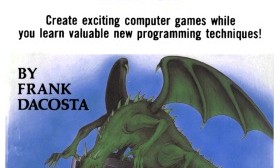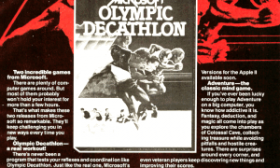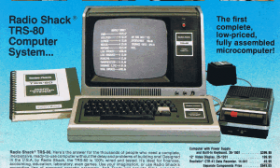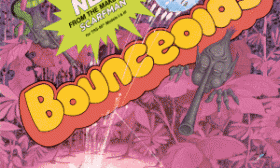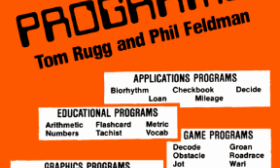To Copy or Not To Copy?
Software piracy and copy protection were hotly debated issues during the early years of the TRS-80 software market. Piracy was blamed (not entirely fairly) for lost sales and the decline of the TRS-80 games market in 1982. As a result, a good percentage of TRS-80 games were copy protected.Classical Mosquito!
Classical Mosquito! was a record of “neo-Baroque” music played entirely by a TRS-80 Model I. It was created by Robb Murray in 1983 and was one of the earliest records consisting solely of computer generated music. The Kids' World Almanac of Records and Facts in 1985 described Classical Mosquito! as “the first commercial record made entirely by computer.”TRS-80 Micro Computer Technical Reference Handbook
The TRS-80 Micro Computer Technical Reference Handbook (catalog number 26–2103), more commonly called the TRS-80 Technical Reference Handbook (even in the Radio Shack catalog), was the official technical reference manual for the TRS-80 Model I. The first edition, which cost $9.95, was printed in 1978. A second edition, revised to reflect later updates to the Model I, was printed in 1982 (one year after the Model I was discontinued).'News From Kitchen Table Software, Inc.
One of the most popular columns in the TRS-80 magazine 80 Microcomputing wasn’t about the TRS-80 at all. In fact, despite appearing to be a news column, it wasn’t about real products or companies. It was “News From Kitchen Table Software, Inc.”, a very amusing humor column introduced by David Busch in the July 1981 issue.
“News From Kitchen Table Software” followed the fictional company Kitchen Table, Inc. (also known as KTI), described as “United States' largest fictitious supplier of space-age computer products.” Kitchen Table was founded by the equally fictitious Scott Nolan Hollerith.
Writing BASIC Adventure Programs for the TRS-80
Adventure games were some of the earliest games written for computers and they were incredibly popular at the beginning of the microcomputer revolution. Despite this popularity, there were only a handful of books that showed how adventure games worked in detail or how to write one. In my opinion, the best book of this type was Writing BASIC Adventure Programs for the TRS-80 by Frank DaCosta. Published in 1982 by TAB Books, Writing BASIC Adventure Programs for the TRS-80 describes two different types of adventure games, with full listings that the reader could type in to the computer. (Both programs were also available through the mail from the author for $19.95 on either disk or tape.)
DaCosta devotes the main part of the book (the first ten chapters) to Basements and Beasties, a classic text adventure in the mold of William Crowther’s original Adventure. After describing how an adventure game works in general, DaCosta lays out the framework needed for a text adventure.
Olympic Decathlon
Olympic Decathlon, sometimes known as Microsoft Olympic Decathlon, was one of the first sports related programs to mix game and simulation. It was written by Timothy W. Smith and sold by Microsoft Consumer Products. The original TRS-80 version cost $24.95 and was released in 1980. It was followed by an Apple II version in 1981 and an IBM PC version in 1982. Although the program used both the word “Olympic” in its title and the Olympic rings symbol, the program manual makes no mention of a license from the International Olympic Committee. The lack of a license might be why the 1982 IBM PC version was renamed Microsoft Decathlon and all references to the Olympics were removed.
Contrary to what is sometimes claimed, Olympic Decathlon was not based on the similar Konami arcade game Track and Field, but actually predated it by several years. Olympic Decathlon was created by Timothy Smith, a former systems programmer for Burroughs Corporation. Smith wanted to write a sports game, but didn’t want to pick an obvious sport such as baseball or basketball. Instead, he chose to base a game on the decathlon, a grueling two-day competition that is comprised of ten track-and-field events:
The Introduction of the TRS-80 (Part 2)
Now that the Radio Shack computer project had been approved by Charles Tandy, the question was how many computers to build. Steve Leininger and Don French both felt that 50,000 units was a reasonable number. That figure was considered laughable (literally) by those in charge, who felt that 1,000 units was more reasonable. (A number that seems absurdly low when you consider that MITS sold 1,000 Altair computers in February 1975 alone.)
The 1,000 target was later increased to 3,000. At the time, Radio Shack had slightly over 3,000 stores. It was decided that if the computer failed to sell, the 3,000 units built could be used in the stores to keep inventory.
Actually, French described it as being phrased “when” the computer failed to sell. There was very little confidence in the project in the upper levels of management at Radio Shack. According to a 1981 InfoWorld article, one executive expressed his disapproval to French with this message: “Don’t waste my time – we can’t sell computers.”
Bounceoids
There were many unofficial adaptations of the Atari arcade game Asteroids written for the TRS-80. Super Nova from Big Five Software and Planetoids from Adventure International were considered among the best.
Bounceoids (not “Bounceroids” as some sources state) was an Asteroids-inspired game written by Robert Pappas (author of Frogger and Crazy Painter) and sold by the Cornsoft Group. It took the concept behind Asteroids and gave it an intriguing twist: what if asteroids didn’t wrap around the sides of the screen, but bounced off the sides instead?
Although this might sound like a minor difference, having the asteroids bounce completely changes the gameplay. The same playing strategies that work in Asteroids (some of which also work in Super Nova and Planetoids) don’t work in Bounceoids. In particular, the movement of the bouncing asteroids means that the player must move almost constantly to avoid them.
TRS-80 Programs: 32 BASIC Programs for the TRS-80 (Level II) Computer
In the early days of microcomputers, books containing “type-in” BASIC programs were common. But probably the book series published for the widest range of computers was the “32 BASIC Programs” series, written by Tom Rugg and Phil Feldman and published by dilithium Press. (The name dilithium was intentionally lowercase.)
Each book contained thirty-two BASIC programs divided into six categories: applications, educational, graphics, game, mathematics, and miscellaneous. Some of the later books added seven extra programs spread across the same categories.
The text of each book was almost identical, sometimes with just the name of the computer changed. Of course, the programs themselves and the screenshots illustrating each program were necessarily different for each new computer.
The TRS-80 entry in the series was titled TRS-80 Programs: 32 BASIC Programs for the TRS-80 (Level II) Computer. Judging by the publication dates, it was the second book in the series, immediately following the Commodore PET version.
